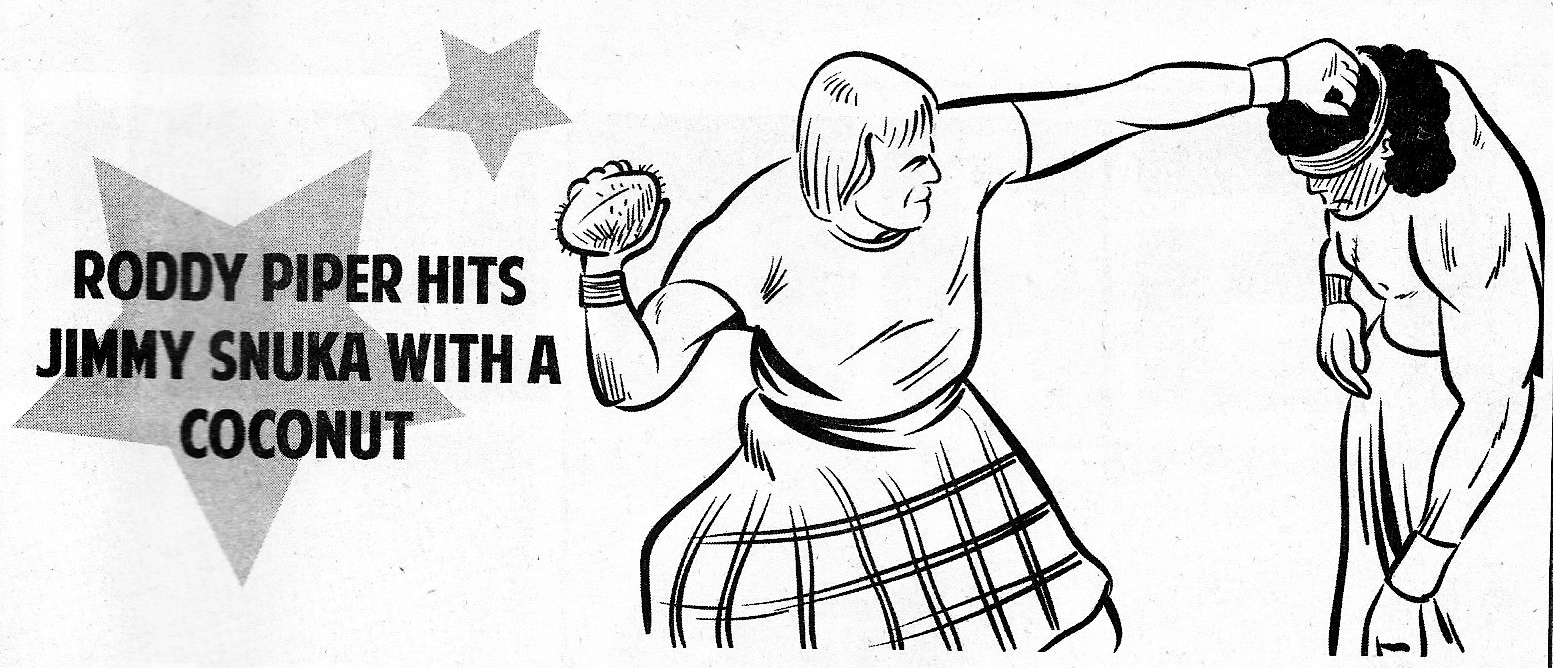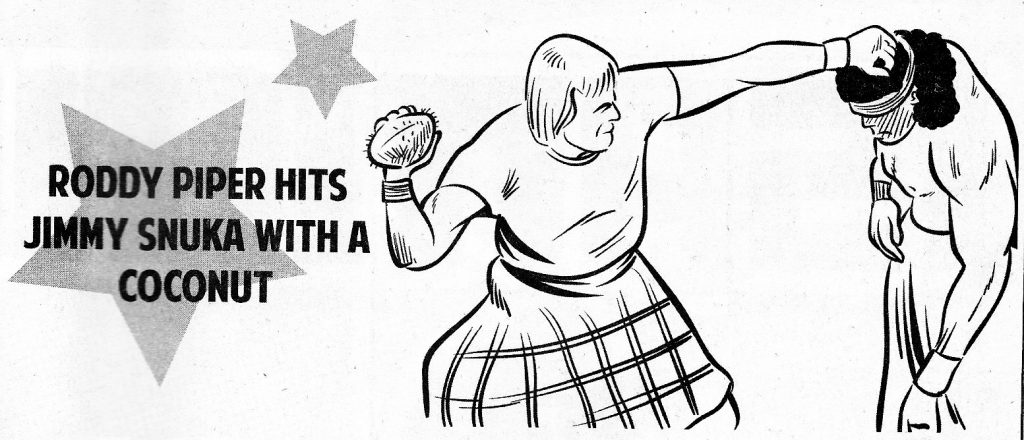One Punk’s Guide to Professional Wrestling: PART FIVE


The Monday Night Wars
Closed-circuit TV had given way to pay-per-view (PPV). Fans no longer had to go to a movie theater to see the big cards. They could buy them through their cable provider and watch from home. WrestleMania and Starrcade continued as yearly events, drawing big numbers and PPV buys. More PPVs were added to the calendar year, quickly making them the most lucrative way for a wrestling promotion to make money. By 1989, the WWF was up to four annually, with more on the way. Even though Vince McMahon had all but monopolized the professional wrestling business and put the territory system out of commission, he still had a small amount of competition.
World Championship Wrestling (WCW) had its roots in the old territory system. In the mid-to-late ’80s, Jim Crockett started buying up NWA territories in a national push to compete with Vince McMahon. These territories were placed under the banner of WCW. Crockett, however, was millions in debt and couldn’t maintain the company any longer. Enter Ted Turner. After purchasing WCW from Crockett, Turner went to work rebuilding the company on a national level.
These early years were not particularly successful. WCW had established stars like Ric Flair, Dusty Rhodes (fresh off a run in WWF), and Ricky Steamboat (also fresh off a WWF run), as well as an impressive stable of up-and-comers like the Steiner Brothers, Lex Luger, and Sting. Their failure lay mostly in the bookings. They chose to go the gimmick route instead of showcasing the talent they had. This was the era of the “Dusty Finish,” named for star and booker, Dusty Rhodes. These finishes were often ambiguous in nature, not having a clear winner, or having the results overturned through some sort of rules violation. Fans were not happy.
Ratings were poor, and the company was once again in trouble. By 1993, WCW had officially withdrawn from the NWA and had begun the process of figuring out just how to compete with the WWF. The answer came in the form of a former AWA announcer, Eric Bischoff.
Eric Bischoff rose in the ranks of WCW rather quickly. Tuner liked him and quickly promoted him from announcer to, eventually, president of the company. Once in control, Bischoff began making moves that were straight out of Vince McMahon’s playbook. By 1995, the company turned a profit for the first time since its purchase in 1991, and things were just getting started.
In 1996, Bischoff started his now-infamous talent raids. Much to Vince McMahon’s dismay, it was his WWF that was being raided. Bischoff first lured away popular WWF star Scott Hall, followed quickly by Kevin Nash. Hall and Nash were branded as an invading force from WWF, and they sold it brilliantly. Fans thought Vince McMahon had planted enemy agents into WCW. Fittingly, they called themselves The Outsiders, paving the way for the most dominant wrestling presence of the 1990s.
Bischoff’s raid of WWF continued with the acquisitions of Gene Okerlund, Randy Savage, and many others, but Hulk Hogan was his biggest prize. If there was anyone who could stop those dastardly Outsiders, it was Hogan. On July 7, 1996, at the Bash on the Beach PPV, Hogan came down the ramp to interfere in Randy Savage and Lex Luger’s match against The Outsiders when the unthinkable happened. Hulk Hogan turned heel with a leg drop on Savage. The New World Order (NWO) was born.
The NWO became a “promotion within a promotion,” recruiting wrestler after wrestler for their stable. Their goal, in an elaborate work, was to disrupt as much WCW programming as possible. They were a type of street gang whose sole purpose was chaos. No babyface was safe from the NWO. It was a ratings goldmine, but it wasn’t the only factor in WCW’s success.
At the same time, WCW was beginning their NWO push, they began pushing their cruiserweight division bringing in talent from Mexico and Japan. Cruiserweights, sometimes called light heavyweights, are usually smaller in stature and engage in a much faster-paced style of wrestling than their heavyweight counterparts. Bischoff also began raiding another up-and-coming company based out of Philadelphia, ECW (Extreme Championship Wrestling). These cruiserweight matches were often opening to mid-card bouts, but the talent involved (Rey Mysterio Jr., Psicosis, Último Dragon, Dean Malenko, Eddie Guerrero, et cetera) was astounding. ECW first brought these foreign stars to the U.S. and established the American ones. WCW simply offered them more money and promised them a national stage on which to continue their feuds. The result was some of the best matches of the decade.
WCW consistently beat WWF in ratings (WCW had Monday Nitro on TNT, and WWF had Raw Is War on USA, airing head to head on Monday nights). Vince McMahon’s response was to change gears. Matches got more violent and the programming became very, very sleazy.
Led by veterans such as Shawn Michaels, The Undertaker, and up-and-coming talent Stone Cold Steve Austin, The Rock, and Mankind (among many others), this became known as the Attitude Era, a mixture of hyper-sexualized gimmicks and ever-increasing bloodshed (a page taken from both the company’s history and the success of ECW). WCW battled back with the rise of, perhaps, their biggest star of the late ’90s, Bill Goldberg, an unstoppable monster and fan favorite who refused to give in to the NWO’s bullying. His winning streak lasted for years and further helped WCW’s ratings reign.
The war was on and WCW seemed unstoppable for a time. However, too much of a good thing isn’t always good for business. The NWO push outlived itself, becoming an increasingly convoluted storyline. The WWF also had simply developed a better roster and was telling much more compelling stories. Fans took notice.
WCW programming became the same thing every week: a match starts, the NWO interferes, repeat. Fans grew tired. Not even Goldberg could electrify them anymore. Meanwhile, the WWF was pushing exciting storylines featuring wrestlers that would go down in history. Steve Austin vs. Vince McMahon, The Rock ‘n’ Sock Connection, Hardys vs. Dudleys vs. Edge and Christian, the Hardcore Division, and the arrival of Kurt Angle were just a few elements that lit a fire for fans. In the span of just a few years, WCW went from being fresh and exciting to second-tier wrestling. With dwindling ratings, by the end, it became difficult to watch.
The details are complicated, but in short, poor backstage management and the WWF’s successful cultivation of new and exciting talent destroyed WCW. Seemingly everyone—myself included—tuned in on March 26, 2001 to watch the last episode of WCW Monday Nitro. We thought we would be seeing a nice farewell. Instead, what we got was news the company was sold to the McMahons, with Vince and his son, Shane, appearing on the show. It was amazing—I remember realizing that, not only was I witnessing a historic moment in wrestling history, but that I was glad to see WCW go.
A few weeks later, ECW declared bankruptcy, effectively breaking my heart. ECW owner Paul Heyman and the owners of the AWA, WCCW, and more would later sell the remaining assets and video libraries to Vince McMahon. Most of the visual history of wrestling now belongs to one company.
And here we are.
Today, wrestling is enjoyed by millions of fans, and an ever-increasing amount of punks, all over the world. The U.S. is currently the largest market for professional wrestling, but Japan and Mexico have had their own highly successful, and highly regarded, promotions for decades as well. Talent trades between these countries and American independent promotions are common. WWE’s developmental territory, NXT (it’s “minor league,” if you will) has proven especially popular among punks and other fans of a more stripped-down product. Somehow, Vince McMahon has tapped into a market that doesn’t care much for his “big” shows (Raw and SmackDown), but gets them to tune in to his “indie” show (which is anything but). It’s a pretty slick deception, considering that NXT’s roster is made up almost entirely of wrestlers who have legitimate independent backgrounds and who have succumbed to the same talent raids that McMahon used back in the early ’80s to build his brand. Why mess with a good thing?
Is wrestling’s popularity among punks and other “hip” groups a trend? It’s difficult to say. I hope the punks stick around, anyway. The infusion of lefty politics, inclusiveness, and ever more progressive locker rooms and storylines can—I like to think anyway—be attributed, at least in part, to punk rock’s growing influence on wrestling.
It’s doubtful that Vince McMahon—who has a net worth of nearly 1.25 billion dollars—will embrace punk rock in any serious capacity any time soon, but the punk invasion of the indies will surely continue for quite some time. However, McMahon’s raids of independent promotions for talent will no doubt continue, making it in the realm of possibility that, someday, there could be a full-on punk invasion of WWE. Wouldn’t that be something?
I for one cannot wait to see what the future holds for DIY and independent pro wrestling. I’d like to be able to easily answer the question “Why do so many punks love wrestling?” but it’s not that simple. Or maybe it is. Punks and wrestlers are both by nature steadfastly individualistic. They live the lives they choose with varying degrees of crazy, but mostly, they do just about everything on their own terms. Even if you have an asshole boss like Vince McMahon.
PART ONE / PART TWO / PART THREE / PART FOUR / PART FIVE
Originally published by RAZORCAKE MAGAZINE.
